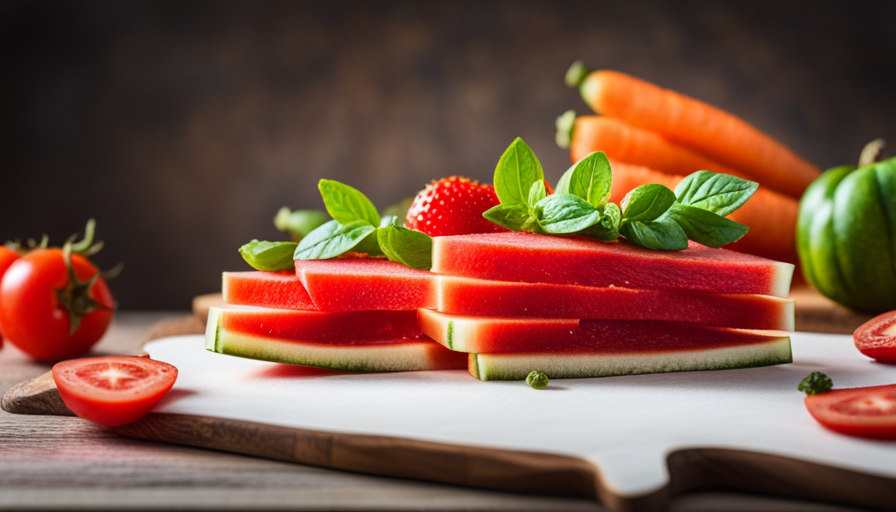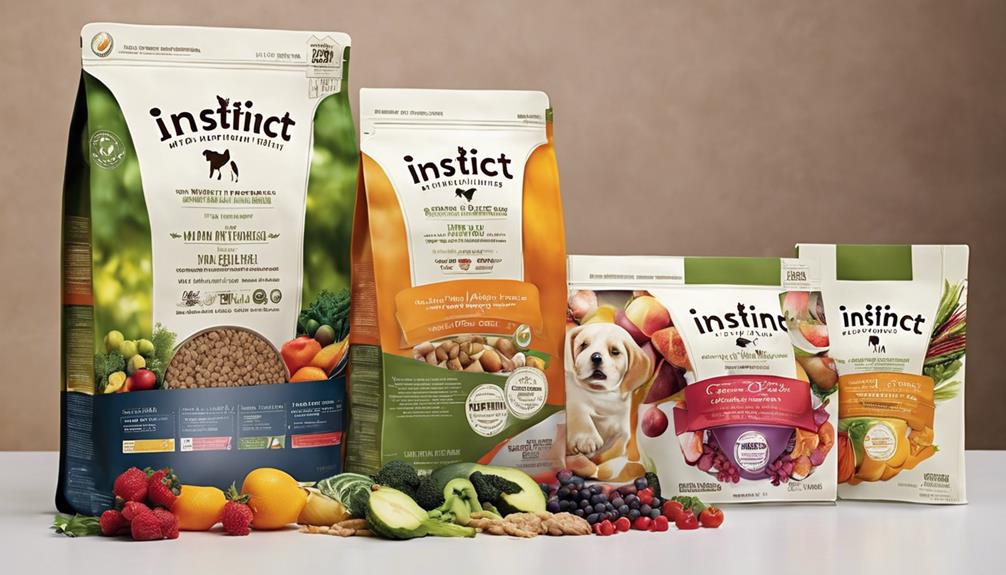There have been times when I’ve had a strong desire for something fresh, vibrant, and full of flavor. That’s when I always opt for raw foods.
Imagine this: it’s a scorching summer day, the sun is blazing, and you’re feeling parched. Suddenly, you spot a juicy watermelon at the local farmer’s market. Without hesitation, you grab it, eagerly anticipating the refreshing burst of sweetness on your tongue. That’s the beauty of raw foods – they offer a plethora of options that are not only delicious but also packed with nutrients.
From crisp vegetables like carrots and bell peppers to flavorful herbs like basil and cilantro, raw foods provide a wide range of flavors and textures to satisfy any craving.
In this article, we’ll explore the world of raw foods and discover the incredible variety of options that are available for us to enjoy. So, let’s dive in and embrace the vibrant and nourishing world of raw foods together!
Key Takeaways
- Raw foods offer fresh, vibrant, and flavorful options that are packed with nutrients.
- Fresh fruits and vegetables, such as leafy greens, crisp vegetables, and sweet dates, can be enjoyed raw and provide essential nutrients.
- Nuts like almonds, walnuts, cashews, and macadamia nuts are nutritious and offer unique flavors and health benefits.
- Healthy seeds like chia seeds, flaxseeds, and pumpkin seeds add crunch and nutrition to meals, improving digestion and boosting energy levels.
Fresh Fruits
You can indulge in the sweet juiciness of fresh fruits, satisfying your cravings for a healthy and refreshing snack. Fresh fruits are not only delicious but also packed with essential nutrients that are beneficial for your overall well-being.
Whether you’re looking for a quick energy boost or a tasty treat, fresh fruits are the perfect choice.
From crispy apples to succulent berries, there is a wide variety of fresh fruits that you can enjoy raw. Bite into a juicy watermelon on a hot summer day, or savor the tanginess of a ripe pineapple. The options are endless!
Not only are these fruits bursting with flavor, but they also provide a wealth of vitamins, minerals, and antioxidants that are essential for maintaining good health.
To add an extra crunch to your fruit medley, consider pairing it with some nutritious nuts. Almonds, walnuts, and cashews are great options that complement the natural sweetness of fresh fruits. These nuts are rich in healthy fats, protein, and fiber, making them a perfect combination for a balanced snack.
Now that you’ve satisfied your sweet tooth with fresh fruits and nutritious nuts, it’s time to move on to the next section about leafy greens. These green powerhouses are not only great for salads but can also be enjoyed raw in various dishes.
Leafy Greens
Leafy greens like spinach and kale can be enjoyed as a refreshing addition to a salad or a crunchy wrap filling. These vibrant greens are not only delicious, but they are also packed with nutrients that are essential for a healthy diet. Incorporating leafy greens into your meals can provide you with a wide range of vitamins, minerals, and antioxidants.
To showcase the nutritional benefits of leafy greens, let’s take a look at the following table:
| Leafy Greens | Nutrients | Benefits |
|---|---|---|
| Spinach | Iron, Vitamin K, Folate, Vitamin C | Supports healthy blood, bones, and immune system |
| Kale | Vitamin A, Vitamin C, Calcium | Promotes eye health and strengthens bones |
| Romaine Lettuce | Vitamin K, Vitamin A, Folate | Supports heart health and aids in digestion |
| Arugula | Vitamin K, Folate, Calcium | Enhances brain function and strengthens bones |
| Swiss Chard | Vitamin K, Vitamin C, Iron | Boosts red blood cell production and supports immunity |
In addition to using leafy greens in salads and wraps, you can also incorporate them into nutrient-rich smoothies. By blending spinach or kale with fruits and other vegetables, you can create a delicious and healthy beverage that will give you a boost of energy and essential nutrients.
Now, let’s move on to the next section and explore the world of crisp vegetables.
Crisp Vegetables
Now, let’s delve into the realm of crisp vegetables and discover the delightful crunch and refreshing flavors they bring to your meals. Crisp vegetables are not only a great addition to salads but also make for crunchy snacks that can satisfy your cravings. Incorporating them into your raw food diet can add variety and texture to your meals.
Here are four examples of crisp vegetables that you can enjoy raw:
-
Carrots: These vibrant orange vegetables aren’t only visually appealing but also provide a satisfying crunch. They’re rich in beta-carotene, which is beneficial for eye health.
-
Bell peppers: Whether you choose red, yellow, or green, bell peppers offer a perfect combination of sweetness and crunch. They’re an excellent source of vitamin C and provide a refreshing taste.
-
Cucumbers: With their high water content, cucumbers are incredibly hydrating and refreshing. They have a mild flavor and a satisfying crunch, making them a great addition to salads or as a snack on their own.
-
Celery: Known for its fibrous stalks, celery offers a satisfying crunch and a mild, refreshing taste. It’s low in calories and packed with vitamins and minerals, making it a nutritious choice for a snack.
Now that we’ve explored crisp vegetables, let’s move on to the next section about nutritious nuts.
Nutritious Nuts
When it comes to nutritious nuts, my go-to options are almonds, walnuts, and cashews. Almonds are packed with vitamin E, while walnuts provide a good source of omega-3 fatty acids. Cashews, on the other hand, offer a great combination of protein and healthy fats.
Additionally, pistachios and pecans are also rich in various nutrients, such as fiber and antioxidants.
Lastly, Brazil nuts and macadamia nuts are known for their high selenium content, which supports immune function and promotes healthy hair and nails.
Almonds, walnuts, and cashews
You can enjoy a handful of almonds, walnuts, or cashews as a nutritious and satisfying raw snack. These tasty nuts are packed with essential nutrients that can benefit your overall health.
Here are a few ways to enjoy them:
- Sprinkle them over a fresh seafood salad for added crunch and flavor.
- Drizzle some raw honey over a handful of walnuts and enjoy the perfect combination of sweetness and nuttiness.
- Mix almonds with dried fruits for a quick and energy-boosting snack on the go.
- Cashews can be blended with water to make a creamy and delicious plant-based milk alternative.
Now, let’s move on to the next section about pistachios and pecans, where we’ll explore more options for enjoying raw nuts.
Pistachios and pecans
After exploring the nutritional benefits of almonds, walnuts, and cashews, let’s move on to two other delicious nuts that can be enjoyed raw: pistachios and pecans.
Pistachios, known for their vibrant green color, are packed with essential nutrients like antioxidants, fiber, and healthy fats. Not only are they a great source of protein, but they also provide important minerals like potassium and vitamin B6.
As for pecans, these buttery and rich nuts are not only delicious, but they also offer numerous health benefits. Pecans are a great source of vitamins and minerals, including vitamin E, magnesium, and zinc. They also contain antioxidants that help reduce inflammation in the body. When it comes to using pecans in recipes, they add a delightful crunch and flavor to both sweet and savory dishes.
Now, let’s dive into the next section about brazil nuts and macadamia nuts.
Brazil nuts and macadamia nuts
Now, let’s dig into the deliciousness of Brazil nuts and macadamia nuts and discover their unique flavors and health benefits.
Brazil nuts are not only tasty but also packed with nutrients. They are a great source of selenium, which plays a crucial role in supporting the immune system and regulating thyroid function. These nuts are also rich in healthy fats, fiber, and protein. They can be enjoyed raw or incorporated into various recipes, such as Brazil nut pesto or granola bars.
Macadamia nuts, on the other hand, have a buttery and creamy texture that is simply irresistible. They are loaded with monounsaturated fats, which can help lower bad cholesterol levels and reduce the risk of heart disease. These nuts are also a good source of fiber, vitamins, and minerals. While macadamia nuts are often enjoyed on their own, they can be used in baking or added to salads for a delightful crunch.
Transitioning to the subsequent section about flavorful herbs, let’s explore some exciting options to enhance our dishes.
Flavorful Herbs
Try adding some fresh and vibrant herbs like basil, cilantro, or mint to your raw dishes for an extra burst of flavor! Not only do herbs add a pop of color to your plate, but they also bring a unique and delightful taste to your meals.
One way to incorporate herbs into your raw dishes is by making herb-infused oils. Simply combine your favorite herbs with olive oil and let it sit for a few hours, allowing the flavors to meld together. This herb-infused oil can then be drizzled over salads or used as a marinade for vegetables.
Another way to use herbs is by creating unique salad dressings. Blend together herbs like basil and cilantro with lemon juice, olive oil, and a touch of honey for a tangy and refreshing dressing. The herbs will infuse the dressing with their aromatic flavors, taking your salads to the next level.
Now, let’s move on to the next section about healthy seeds, which are another fantastic addition to raw dishes.
Healthy Seeds
Sprinkle these healthy seeds onto your dishes and watch as your taste buds are transformed into a state of utter bliss. Healthy seeds, such as chia seeds, flaxseeds, and pumpkin seeds, not only add a delightful crunch to your meals but also provide a wealth of nutritional benefits.
Chia seeds, for instance, are packed with omega-3 fatty acids, fiber, and antioxidants, making them a great addition to any dish. Flaxseeds are rich in fiber and lignans, which have been shown to have anti-inflammatory properties. Pumpkin seeds, on the other hand, are a great source of protein, iron, magnesium, and zinc.
Incorporating these healthy seeds into your diet can help improve digestion, boost energy levels, and support a healthy immune system.
To enhance the flavors of these seeds, you can combine them with flavorful herbs like basil, cilantro, or dill. The combination of the earthy, nutty taste of the seeds with the aromatic and fresh flavors of the herbs creates a harmonious blend that will make your taste buds sing.
Now, let’s move on to the next section about creamy avocado.
Creamy Avocado
I absolutely love exploring different healthy seeds and incorporating them into my diet. They’re packed with nutrients and offer a delightful crunch to my meals.
Now, let’s talk about another versatile ingredient that I can enjoy raw – the creamy avocado. Creamy avocado is not only delicious but also offers numerous health benefits. It’s a great source of healthy fats, fiber, and vitamins. Incorporating it into my diet helps me maintain a healthy heart, improve digestion, and boost my immune system.
There are so many delicious recipes that I can make with creamy avocado. I can whip up a refreshing avocado salad with cherry tomatoes, cucumber, and a tangy dressing. Or I can spread it on my toast and top it with a sprinkle of sea salt and a squeeze of lime. The possibilities are endless!
Creamy avocado is a versatile and nutritious ingredient that I enjoy eating raw. Its delicious taste and health benefits make it a staple in my diet.
Now, let’s move on to the next section and discover the wonders of sweet dates.
Sweet Dates
Indulge in the luscious sweetness of dates, a delectable addition to any dish. Not only are they a delicious treat, but sweet dates also serve as a natural sweetener, making them a healthier alternative to refined sugar. When it comes to incorporating sweet dates into recipes, the possibilities are endless.
One way to enjoy the natural sweetness of dates is by using them as a topping for your morning oatmeal or yogurt. Simply chop up a few dates and sprinkle them on top for a burst of sweetness and added texture. You can also blend dates with almond milk and a handful of ice to create a creamy and nutritious smoothie.
If you’re feeling more adventurous, try incorporating sweet dates into savory dishes. For example, you can stuff dates with cheese and wrap them in bacon for a delightful appetizer. Dates can also be added to salads or roasted alongside vegetables for a touch of sweetness.
Transitioning into the next section about protein-packed legumes, let’s explore the world of nutritious and filling beans and lentils.
Protein-Packed Legumes
I absolutely love incorporating protein-packed legumes into my diet. Two of my favorite legumes are chickpeas and lentils, which aren’t just delicious but also incredibly nutritious. They’re a fantastic source of plant-based protein, fiber, and essential minerals like iron and magnesium.
Another duo that I often enjoy is black beans and kidney beans. These legumes aren’t only packed with protein, but they also provide a good amount of dietary fiber and antioxidants.
Lastly, edamame and green peas are two legumes that I frequently snack on. They aren’t just a great source of protein, but they also contain vitamins and minerals, including vitamin K, folate, and manganese.
Chickpeas and lentils
Chickpeas and lentils are versatile legumes that can be enjoyed raw, and did you know that they’re packed with protein, providing an average of 15-20 grams per cup? These legumes offer a wide range of culinary possibilities, from salads to snacks.
For chickpea lovers, you can make delicious hummus or even roast them for a crunchy snack. Lentils, on the other hand, are a great addition to soups, stews, and salads, offering a hearty texture and earthy flavor.
Not only are chickpeas and lentils tasty, but they also offer numerous nutritional benefits. They’re rich in fiber, vitamins, and minerals such as iron and folate. So, if you’re looking for a nutritious and protein-packed addition to your diet, chickpeas and lentils are the way to go.
Now, let’s move on to the next legume section about black beans and kidney beans.
Black beans and kidney beans
Black beans and kidney beans are a deliciously satisfying option that will leave your taste buds craving for more. These versatile legumes can be enjoyed raw or cooked, adding a nutritious punch to any dish. Black beans are a great addition to salads, salsas, and even desserts like brownies. They are packed with fiber, protein, and antioxidants, promoting digestive health and reducing the risk of chronic diseases. On the other hand, kidney beans are known for their rich, hearty flavor and smooth texture. They are commonly used in chili recipes and bean salads. Kidney beans offer numerous health benefits, including improved heart health and regulated blood sugar levels. Now, let’s move on to the next section where we will explore the wonders of edamame and green peas.
Edamame and green peas
Edamame and green peas are a delightful duo that will have your taste buds dancing with joy. Edamame, also known as soybeans, are a popular ingredient in many Asian dishes, especially in Japan. They can be enjoyed raw as a snack or cooked and added to salads, stir-fries, or sushi rolls.
Green peas, on the other hand, are a versatile legume that can be eaten both raw and cooked. They’re packed with nutrients like fiber, protein, and vitamins A, C, and K. Green peas can be used in a variety of recipes, including soups, stews, and even mashed into a spread.
Incorporating these vibrant green vegetables into your diet not only adds a burst of flavor but also provides numerous health benefits.
Moving on to tasty sushi rolls, they’re a perfect way to showcase the freshness of raw ingredients.
Tasty Sushi Rolls
Indulge in the mouthwatering flavors of sushi rolls, bursting with freshness and creativity. Sushi rolls are a delightful and popular dish that can be enjoyed in various flavors and combinations. Whether you’re a sushi aficionado or a newbie, there is a sushi roll recipe out there to suit everyone’s taste buds.
When it comes to sushi roll ingredients, the possibilities are endless. From classic combinations like California rolls with crab, avocado, and cucumber, to more adventurous options like spicy tuna rolls or tempura shrimp rolls, there is something for everyone. The key to a tasty sushi roll lies in the freshness and quality of the ingredients. Fresh fish, crisp vegetables, and perfectly cooked rice are the building blocks for a delicious sushi roll.
To make it easier for you to navigate through the world of sushi rolls, here is a table showcasing some popular sushi roll recipes and their ingredients:
| Sushi Roll | Ingredients |
|---|---|
| California Roll | Crab, Avocado, Cucumber, Nori (Seaweed), Sushi Rice |
| Spicy Tuna Roll | Tuna, Spicy Mayo, Cucumber, Nori (Seaweed), Sushi Rice |
| Tempura Shrimp Roll | Tempura Shrimp, Avocado, Cucumber, Nori (Seaweed), Sushi Rice |
| Veggie Roll | Carrot, Cucumber, Avocado, Bell Pepper, Nori (Seaweed), Sushi Rice |
With these sushi roll recipes and ingredients, you can unleash your creativity and customize your rolls according to your preferences. So go ahead and explore the world of sushi rolls, and enjoy the delightful flavors they have to offer!
Frequently Asked Questions
Can you eat the skin of fruits like apples and peaches?
Yes, it’s safe to eat the skin of fruits like apples and peaches. The skin of these fruits is not only edible but also packed with nutrients and fiber. It adds a crunchy texture and enhances the flavor of the fruit. However, it’s important to wash the fruits thoroughly before consuming them to remove any dirt or pesticides that may be present on the skin.
Are all leafy greens safe to eat raw, or are there some that need to be cooked?
Leafy greens, while generally safe to eat raw, can also benefit from cooking methods that enhance their flavors and textures. Sautéing, blanching, or steaming leafy greens can help soften their fibrous texture and mellow their bitterness.
However, consuming raw leafy greens provides maximum nutritional benefits, as cooking can diminish certain vitamins and antioxidants. Therefore, incorporating a combination of raw and cooked leafy greens into one’s diet ensures a well-rounded intake of nutrients.
What are some examples of crisp vegetables that can be enjoyed raw?
Crisp vegetables such as cucumbers, carrots, bell peppers, and radishes are excellent choices to enjoy raw. They provide a refreshing crunch and are packed with nutritional benefits.
Cucumbers are hydrating and contain vitamins and minerals. Carrots are rich in beta-carotene and promote healthy vision. Bell peppers are high in vitamin C and antioxidants. Radishes are low in calories and high in fiber.
These vegetables can be sliced and enjoyed in salads or used as crunchy dippers.
Are all nuts safe to eat raw, or are there some that need to be roasted or cooked?
Are all nuts safe to eat raw or should some be roasted or cooked?nnRaw nuts are generally safe to eat, but there are a few exceptions. Certain nuts, such as almonds, are commonly consumed raw. However, others like cashews contain a toxic resin that must be removed through roasting.
In terms of health benefits, raw nuts are often considered healthier than roasted ones, as the roasting process can reduce some of their nutritional value. However, it’s important to note that raw nuts should still be consumed in moderation due to their high calorie content.
Can you eat all herbs raw, or are there certain ones that should be cooked or used as a garnish only?
Certain herbs can be eaten raw, while others are best used as a garnish or cooked. Eating raw herbs can provide various health benefits, such as increased antioxidant intake and improved digestion. To incorporate raw herbs into your diet, you can add them to salads, smoothies, or homemade dressings. Additionally, you can infuse water or oil with herbs for a refreshing and flavorful twist. Remember to wash the herbs thoroughly before consuming them raw.
Can I Eat Raw Shrimp Safely?
Eating raw shrimp poses a risk of foodborne illness due to potential bacteria and parasites. Consuming undercooked shrimp also increases the likelihood of experiencing the strong and unpleasant tasting raw shrimp flavor. To enjoy seafood safely, it’s best to cook shrimp thoroughly before consuming.
Conclusion
In conclusion, there’s a wide variety of food that can be enjoyed raw, providing not only delicious flavors but also essential nutrients.
From the refreshing juiciness of fresh fruits to the crispness of leafy greens and vegetables, there are plenty of options to choose from.
Nuts and herbs add a delightful burst of flavor, while creamy avocado and sweet dates offer a satisfying indulgence.
Don’t forget about protein-packed legumes and tasty sushi rolls for a more substantial raw meal.
So, go ahead and explore the raw food world – it’s a piece of cake!










